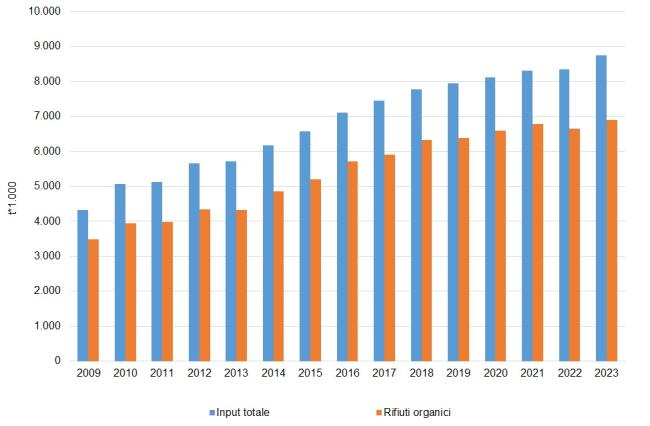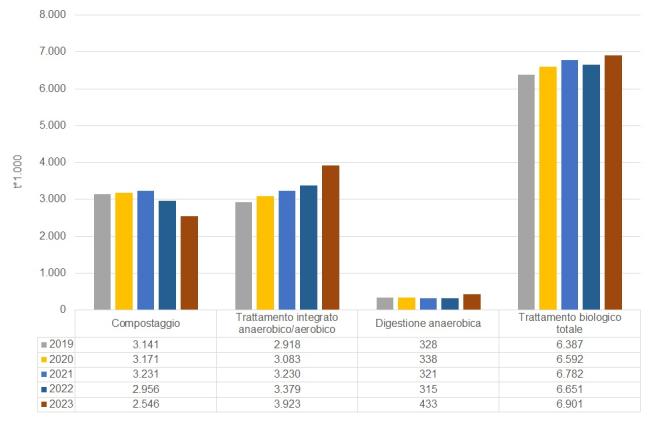Panel 1
Letteria Adella
The indicator measures the quantity of waste sent for biological treatment, specifically composting, integrated anaerobic/aerobic treatment, and anaerobic digestion. In 2023, the total amount of waste recovered through biological treatment processes (8.7 million tonnes) shows an increase of approximately 392 thousand tonnes (+4.7%) compared to 2022. A similar trend is observed for the share of organic waste from separate collection, which increased from approximately 6.7 million tonnes to 6.9 million tonnes, showing a growth of 250 thousand tonnes (+3.8%).
The indicator measures the quantity of waste sent for biological treatment overall and, in detail, the quantities sent for composting, integrated anaerobic/aerobic treatment, and anaerobic digestion.
Verify the effectiveness of policies aimed at promoting material recovery from waste.
Direttiva (UE) 2018/851 relativa ai rifiuti;
Direttiva (UE) 2018/852 sugli imballaggi e rifiuti di imballaggio;
Decreto legislativo 152/2006 e successive modificazioni;
Decreto legislativo 29 aprile 2010, n. 75 e successive modificazioni;
DM 5 febbraio 1998.
Panel 2
Rapporto Rifiuti Urbani - Edizione 2024
Data quality assessment
ISPRA (Italian National Institute for Environmental Protection and Research)
The data used come from the MUD declaration database and from specific questionnaires sent to ARPA/APPA and plant operators, and are available on the waste registry website (http://www.catasto-rifiuti.isprambiente.it).
NaTionale, Regional
1998-2023
Indicator assessment
The indicator measures the quantity of waste sent for biological treatment, specifically composting, integrated anaerobic/aerobic treatment, and anaerobic digestion. Information on plant infrastructure and waste quantities was collected through specific questionnaires sent to regional and provincial environmental protection agencies, Regions, Provinces, and regional and provincial Waste Observatories, as well as to plant operators. The data were validated through comparison with the MUD database and detailed cross-checks carried out at the level of individual plants.
In recent years, there has been a significant increase in the separate collection of organic waste, although some areas have not yet reached optimal levels. This trend has driven substantial development in the biological treatment sector, which has evolved through the adoption of innovative plant technologies. Alongside traditional aerobic treatment systems aimed at producing soil improvers for agricultural use, the national plant infrastructure has progressively integrated systems that combine aerobic treatment with anaerobic digestion, thereby enabling both material and energy recovery, reducing emissions, and using the generated and purified biogas for energy and biomethane production.
In 2023 as well, the entire sector was characterized by modernization of the national plant network, with a reduction of 10 composting plants offset by the commissioning of 10 integrated treatment plants (7 converted from aerobic treatment and 3 newly built) and 5 new anaerobic digestion plants. As a result, the overall treatment capacity increased from approximately 12 million tonnes to 12.3 million tonnes.
The entire system consists of 363 plants, specifically: 275 dedicated to aerobic treatment only (composting), 61 integrated anaerobic/aerobic treatment plants, and 27 anaerobic digestion plants (Tables 1, 2, and 3).
In 2023, the total amount of waste recovered through biological treatment processes (8.7 million tonnes) shows an increase of approximately 392 thousand tonnes (+4.7%) compared to 2022. A similar trend is observed for the share of organic waste from separate collection, which rose from approximately 6.7 million tonnes to 6.9 million tonnes, showing an increase of 250 thousand tonnes (+3.8%) (Figure 1).
Consistent with the trend in separate collection, the analysis of data on biological treatment as a whole shows a continuous growth of the sector, both in terms of total quantities treated (+102% between 2009 and 2022) and specifically regarding the organic fraction, which increased by 98% over the same period (Figure 1).
With regard to the treatment of the organic fraction from separate collection in the period 2019–2023 (Figure 2), it is clear that anaerobic digestion processes combined with aerobic treatment have significantly contributed to the progress made in recent years in the recovery of organic waste.
In particular, the composting sector, which saw a reduction of 10 operational plants — 7 of which were converted to integrated anaerobic/aerobic treatment — experienced a progressive decline that, in the last year, amounted to 410 thousand tonnes, equal to a 13.9% decrease compared to 2022 (–595 thousand tonnes, –19% compared to 2019).
In contrast, integrated treatment has shown constant growth, supported also by the increased number of operational units (+10 plants between 2022 and 2023), with an additional 543 thousand tonnes treated (+16.1%; +34.4% compared to 2019).
Anaerobic digestion also recorded similar growth, with five new plants entering operation and an increase of 118 thousand tonnes between 2022 and 2023 (+37.3%; +32% compared to 2019).
The data analysis therefore confirms the growing importance of dedicated anaerobic processes and, especially, their combination with aerobic treatment in managing the organic fractions from separate collection.
Integrated anaerobic/aerobic treatment plants, whose number increased by 20 units between 2019 and 2023, have been decisive in the increase of recovered organic waste quantities thanks to their dual capability: on one hand, producing high-quality soil improvers in compliance with fertilizer regulations for agricultural use; on the other, utilizing the generated biogas directly for combined heat and power generation and/or further purified for biomethane production, intended for use in transport and as a substitute for natural gas.
Data
Tabella 1: Compostaggio dei rifiuti, per regione
ISPRA
a Rifiuti di carta, cartone, legno, rifiuti provenienti da comparti industriali (agroalimentare, tessile, carta, legno), rifiuti da trattamento aerobico e anaerobico dei rifiuti.
Tabella 2: Trattamento integrato anaerobico/aerobico dei rifiuti, per regione
ISPRA


The analysis of data relating to the composting sector shows that the conversion of some plants from aerobic treatment to integrated (anaerobic/aerobic) treatment, and the consequent diversion of organic waste flows to this new management approach, have led to a decrease in the quantities of waste sent for composting. The negative trend already observed in 2022 is thus confirmed: the total quantity of waste treated, amounting to 3.4 million tonnes, shows a reduction of 400 thousand tonnes compared to 2022 (–10.6%).
The decline is even more pronounced for the organic fraction from separate collection, which, at over 2.5 million tonnes, recorded a decrease of 13.9%, corresponding to over 410 thousand tonnes. In particular, there was a further reduction of over 500 thousand tonnes in the aerobic treatment of the wet fraction, equal to a 29.4% decrease.
In contrast, a reversal of trend is observed for green waste treatment, which, in line with the increase in separate collection, shows an increase of about 97 thousand tonnes (+7.9%).
In Northern Italy, where more than 60% of integrated plants and 85% of anaerobic digestion-only plants are located, there was a decrease of six composting plants. The quantities treated in this area (1.2 million tonnes, or 47.6% of the national total) show a decrease of 69 thousand tonnes compared to 2022 (–5.4%).
The negative trend is even more significant in Central Italy, where four composting plants closed, leading to a drop of about 142 thousand tonnes in managed organic waste (–30.9%), bringing the total to over 316 thousand tonnes (12.4% of the national total).
In Southern Italy, where just over 1 million tonnes of separately collected waste (39.9% of the national total) is sent to composting, there was a reduction of about 200 thousand tonnes compared to 2022 (–16.4%). In this area, the number of composting plants remained unchanged, while four new integrated treatment plants started operation.
The integrated anaerobic/aerobic treatment sector recorded further growth between 2022 and 2023, with a total of 4.3 million tonnes of waste treated — an increase of about 690 thousand tonnes (+18.8%) compared to 2022. The organic fraction from separate collection alone (3.9 million tonnes) grew by 543 thousand tonnes (+16.1%).
A detailed analysis of the three macro-regions shows general sector growth. The North recorded the highest quantitative increase (+326 thousand tonnes, +11.6%), supported by the start-up of four additional treatment units, two of which were converted from aerobic treatment.
Central Italy saw a higher percentage increase (+44.3%, or +128 thousand tonnes), with two new operational plants, both converted from aerobic treatment.
Southern Italy also experienced modernization of treatment infrastructure, with four new plants (one converted from aerobic treatment), resulting in an increase of 89 thousand tonnes in organic waste treated (+31.9% compared to 2022).
The anaerobic digestion sector also saw further development last year, with five new operational units. While its contribution to organic waste recovery is smaller compared to integrated treatment, it remains significant.
The total quantity of waste sent to anaerobic digestion exceeded 989 thousand tonnes, showing an increase of 105 thousand tonnes (+11.9%) compared to the previous survey.
The organic fraction from separate collection also increased by 118 thousand tonnes, reversing the decline seen in 2021–2022 and returning to growth (+37.3%).
All areas of the country recorded positive trends. In the North, where 23 of the 27 operational plants are located, there was an increase of 92 thousand tonnes (+37.1%), with managed organic waste totaling over 340 thousand tonnes (78.7% of the national total).
The increase was even more pronounced in Central Italy, where a new plant started operation and another reached full capacity, resulting in an increase from about 13 thousand tonnes in 2022 to about 29 thousand tonnes in 2023 (6.6% of the national total).
In Southern Italy, the two operational plants in Molise treated around 64 thousand tonnes of organic matrices (14.7% of the national total), showing an increase of about 10 thousand tonnes compared to 2022 (+17.6%).